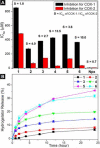D-amino acids boost the selectivity and confer supramolecular hydrogels of a nonsteroidal anti-inflammatory drug (NSAID)
- PMID: 23136972
- PMCID: PMC3547157
- DOI: 10.1021/ja310019x
D-amino acids boost the selectivity and confer supramolecular hydrogels of a nonsteroidal anti-inflammatory drug (NSAID)
Abstract
As systemically used therapeutics for treating acute or chronic pains or inflammations, nonsteroidal anti-inflammatory drugs (NSAIDs) also associate with the adverse gastrointestinal and renal effects and cardiovascular risks. Thus, it is beneficial to develop topical gels that selectively inhibit cyclooxygenase-2 (COX-2) for the management of local inflammation. In this work, we demonstrate that the covalent conjugation of d-amino acids to naproxen (i.e., a NSAID) not only affords supramolecular hydrogelators for the topical gels but also unexpectedly and significantly elevates the selectivity toward COX-2 about 20× at little expense of the activity of naproxen. This work illustrates a previously unexplored approach that employs d-amino acids for the development of functional molecules that have dual or multiple roles and exceptional biostability, which offers a new class of molecular hydrogels of therapeutic agents.
Figures




Similar articles
-
Instructed Assembly of Peptides for Intracellular Enzyme Sequestration.J Am Chem Soc. 2018 Dec 5;140(48):16433-16437. doi: 10.1021/jacs.8b10542. Epub 2018 Nov 21. J Am Chem Soc. 2018. PMID: 30452246 Free PMC article.
-
β-Amino acid and amino-alcohol conjugation of a nonsteroidal anti-inflammatory drug (NSAID) imparts hydrogelation displaying remarkable biostability, biocompatibility, and anti-inflammatory properties.Langmuir. 2013 Aug 13;29(32):10254-63. doi: 10.1021/la401929v. Epub 2013 Aug 1. Langmuir. 2013. PMID: 23859562
-
The conjugation of nonsteroidal anti-inflammatory drugs (NSAID) to small peptides for generating multifunctional supramolecular nanofibers/hydrogels.Beilstein J Org Chem. 2013 May 10;9:908-17. doi: 10.3762/bjoc.9.104. Print 2013. Beilstein J Org Chem. 2013. PMID: 23766806 Free PMC article.
-
Exploring the properties and potential biomedical applications of NSAID-capped peptide hydrogels.Soft Matter. 2020 Nov 18;16(44):10001-10012. doi: 10.1039/d0sm01198c. Soft Matter. 2020. PMID: 32789370 Review.
-
Computer aided drug design approaches to develop cyclooxygenase based novel anti-inflammatory and anti-cancer drugs.Curr Pharm Des. 2007;13(34):3505-17. doi: 10.2174/138161207782794275. Curr Pharm Des. 2007. PMID: 18220787 Review.
Cited by
-
Ultrashort Peptide Self-Assembly: Front-Runners to Transport Drug and Gene Cargos.Front Bioeng Biotechnol. 2020 May 29;8:504. doi: 10.3389/fbioe.2020.00504. eCollection 2020. Front Bioeng Biotechnol. 2020. PMID: 32548101 Free PMC article. Review.
-
D-amino acids modulate the cellular response of enzymatic-instructed supramolecular nanofibers of small peptides.Biomacromolecules. 2014 Oct 13;15(10):3559-68. doi: 10.1021/bm5010355. Epub 2014 Sep 17. Biomacromolecules. 2014. PMID: 25230147 Free PMC article.
-
Peptide-Based Supramolecular Hydrogels for Delivery of Biologics.Bioeng Transl Med. 2016 Sep;1(3):306-322. doi: 10.1002/btm2.10041. Bioeng Transl Med. 2016. PMID: 28989975 Free PMC article.
-
High drug payload nanoparticles formed from dexamethasone-peptide conjugates for the treatment of endotoxin-induced uveitis in rabbit.Int J Nanomedicine. 2019 Jan 14;14:591-603. doi: 10.2147/IJN.S179118. eCollection 2019. Int J Nanomedicine. 2019. PMID: 30666116 Free PMC article.
-
Enzymatic noncovalent synthesis of peptide assemblies generates multimolecular crowding in cells for biomedical applications.Chem Commun (Camb). 2021 Dec 3;57(96):12870-12879. doi: 10.1039/d1cc05565h. Chem Commun (Camb). 2021. PMID: 34817487 Free PMC article. Review.
References
-
- Silverstein FE, Faich G, Goldstein JL, Simon LS, Pincus T, Whelton A, Makuch R, Eisen G, Agarwal NM, Stenson WF, Burr AM, Zhao WW, Kent JD, Lefkowith JB, Verburg KM, Geis GS. JAMA-J. Am. Med. Assoc. 2000;284:1247–1255. - PubMed
-
- Catella-Lawson F, Reilly MP, Kapoor SC, Cucchiara AJ, DeMarco S, Tournier B, Vyas SN, FitzGerald GA. N. Engl. J. Med. 2001;345:1809–1817. - PubMed
-
- Bresalier RS, Sandler RS, Quan H, Bolognese JA, Oxenius B, Horgan K, Lines C, Riddell R, Morton D, Lanas A, Konstam MA, Baron JA, Investigators APT. N. Engl. J. Med. 2005;352:1092–1102. - PubMed
-
- Banning M. Expert Opin. Pharmacotherapy. 2008;9:2921–2929. - PubMed
Publication types
MeSH terms
Substances
Grants and funding
LinkOut - more resources
Full Text Sources
Other Literature Sources
Research Materials

